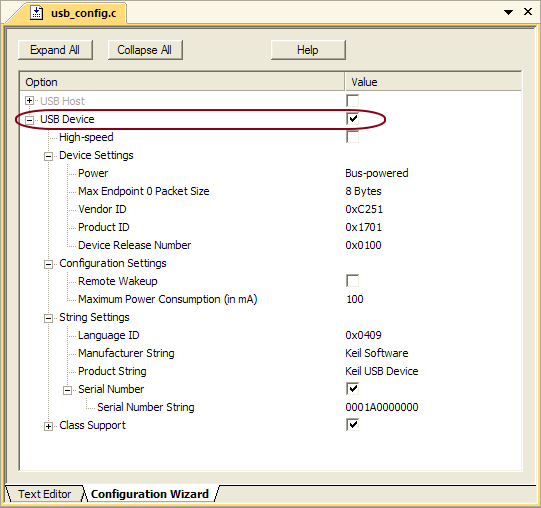|
||
| Products Download Events Support Videos | ||
Technical Support
On-Line Manuals
RL-ARM User's Guide (MDK v4)
RL-USB Device Configuration
RL-USB Device Configuration explains the options offered by the RL-USB Library for configuring USB Devices. Options are set in the file usb_config.c directly or using the µVision Configuration Wizard.

Where
-
USB Device - enables the USB Device functionality. This
option corresponds to #define USBD_ENABLE.
#define USBD_ENABLE 1
-
High Speed - enables high speed support, if supported by
the microcontroller. This option corresponds to #define
USBD_HS_ENABLE.
#define USBD_ENABLE 0
Device Settings
configure the settings of the USB Device that affect Device Descriptor.
configure the settings of the USB Device that affect Device Descriptor.
-
Power sets default power source, Bus-powered or
Self-powered. This option corresponds to
#define USBD_POWER.
#define USBD_POWER 0 // 0 = Bus-powered; 1 = Self-powered;
-
Max Endpoint 0 Packet Size sets the maximum packet size
of endpoint 0 (bMaxPacketSize0). Values of 8, 16, 32, and 64
Bytes are possible. This option corresponds to
#define USBD_MAX_PACKET0.
#define USBD_MAX_PACKET0 8 // 8, 16, 32, and 64 Bytes
-
Vendor ID sets the vendor identification number
(idVendor) assigned by the USB-IF. Values between 0x0000-0xFFFF
are valid. This option corresponds to
#define USBD_DEVDESC_IDVENDOR.
#define USBD_DEVDESC_IDVENDOR 0xC251 // ask USB-IF for a valid ID
-
Product ID sets the product identification number
(idProduct) assigned by the manufacturer. Values between
0x0000-0xFFFF are valid. This option corresponds to
#define USBD_DEVDESC_IDPRODUCT.
#define USBD_DEVDESC_IDPRODUCT 0x1705 // ask the manufacturer for a valid ID
-
Device Release Number sets the product release number
(bcdDevice) assigned by the manufacturer. Values between
0x0000-0xFFFF are valid. This option corresponds to
#define USBD_DEVDESC_BCDDEVICE.
#define USBD_DEVDESC_BCDDEVICE 0x0100 // ask manufacturer for release number
Configuration Settings
configure the settings of the USB Device that affect Configuration Descriptor.
configure the settings of the USB Device that affect Configuration Descriptor.
-
Remote Wakeup sets the wakeup attribute (D5: of
bmAttributes). This option corresponds to
#define USBD_CFGDESC_BMATTRIBUTES.
#define USBD_CFGDESC_BMATTRIBUTES 0xA0
-
Maximum Power Consumption (in mA) sets the maximum power
consumption (bMaxPower) allowed when the device is fully
operational. Values between 0..510 are possible. This option
corresponds to #define USBD_CFGDESC_BMAXPOWER.
#define USBD_CFGDESC_BMAXPOWER 0x32 // value range 0..510
String Settings
configure the language, manufacturer name, product name, and product serial number.
configure the language, manufacturer name, product name, and product serial number.
-
Language ID sets the language. Numbers between
0x0000-0xFCFF are valid. This option corresponds to
#define USBD_STRDESC_LANGID.
#define USBD_STRDESC_LANGID 0x0409 // 0x0409 - English (United States)
-
Manufacturer String sets the manufacturer name. The
string can have 126 characters. This option corresponds to
#define USBD_STRDESC_MAN.
#define USBD_STRDESC_MAN L"Keil Software" // max. 126 characters
-
Product String sets the product name. The string can
have 126 characters. This option corresponds to
#define USBD_STRDESC_PROD.
#define USBD_STRDESC_PROD L"Keil USB Device" // max. 126 characters
-
Serial Number enables the serial number string. This
option corresponds to
#define USBD_STRDESC_SER_ENABLE.
#define USBD_STRDESC_SER_ENABLE 1 // 1=enabled; 0=disabled;
-
Serial Number String sets the serial number. This option
corresponds to #define USBD_STRDESC_SER.
#define USBD_STRDESC_SER L"0001A0000000" // max. 126 characters
Class Support
enables class specific requests. This option corresponds to #define USBD_CLASS_ENABLE.
enables class specific requests. This option corresponds to #define USBD_CLASS_ENABLE.
#define USBD_CLASS_ENABLE 1 // 1=enabled; 0=disabled;
The USB Device class options are explained in:
- Audio Device (ADC) Options
- Communication Device (CDC) - Abstract Control Model (ACM) Options
- Human Interface Device (HID) Options
- Mass Storage Device (MSC) Options
- Custom Class Device enables custom class requests. It can be used to implement additional classes to those mentioned above.
Note
- Refer to Create USB Device Applications to build an USB Device application.
ProductsDevelopment Tools |
Hardware & Collateral |
Downloads |
Support |
Contact |
